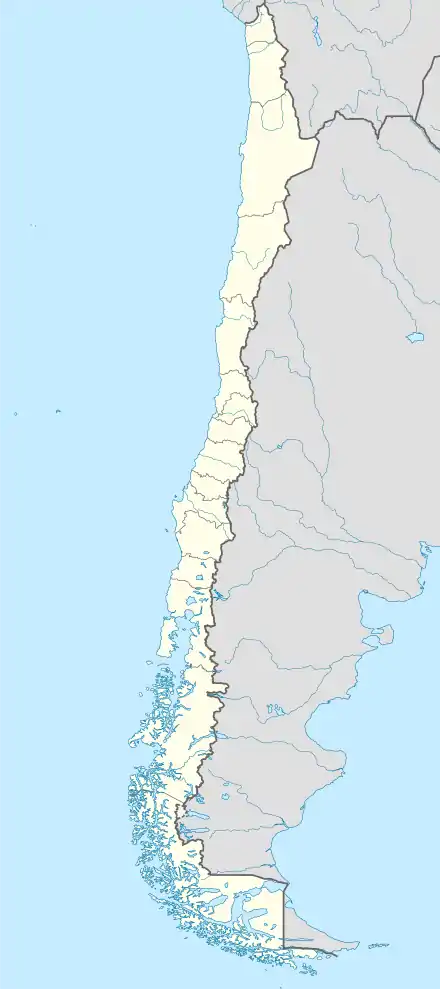Santiago (commune)
The Commune of Santiago is the central commune of the Santiago Province, located at the center of the Santiago Metropolitan Region in Chile's Central Zone. Locally, Santiago is usually abbreviated Stgo. It is also called as "Santiago Centro" (Downtown Santiago) in order to differentiate it from Greater Santiago, a larger entity which includes Santiago Commune along with other 36 communes.
Santiago | |
|---|---|
 The Skyline of Santiago Commune Financial and Commercial Center | |
 Flag .svg.png.webp) Coat of arms   Santiago Location in Chile | |
| Coordinates (city): 33°26′14″S 70°39′02″W | |
| Country | Chile |
| Region | Santiago Metro. |
| Province | Santiago |
| Established | February 12, 1541 |
| Government | |
| • Type | Municipality |
| • Mayor | Felipe Alessandri (RN) |
| Area | |
| • Total | 22.4 km2 (8.6 sq mi) |
| Elevation | 579 m (1,900 ft) |
| Population (2002 Census)[4] | |
| • Total | 200,792 |
| • Density | 9,000/km2 (23,000/sq mi) |
| • Urban | 200,792 |
| • Rural | 0 |
| Sex | |
| • Men | 99,155 |
| • Women | 101,637 |
| Time zone | UTC-4 (CLT [5]) |
| • Summer (DST) | UTC-3 (CLST [6]) |
| Website | Municipality of Santiago |
History
The city of Santiago was founded on February 12, 1541 as "Santiago de la Nueva Extremadura" by Pedro de Valdivia. It is officially the provincial, regional and national capital. It encompasses the oldest part of the city —that enclosed by old rail lines—, including downtown, and houses all major government infrastructure, including the government palace La Moneda.[7]
Demographics
According to the 2002 census of the National Statistics Institute, the commune has an area of 22.4 km2 (9 sq mi) and a population of 200,792 (99,155 men and 101,637 women), giving it a population density of 8,963.9/km2 (23,216/sq mi). The population shrank by 13.1% (30,185 persons) in the ten years since the 1992 population of 230,977.[4] In 2002, there were 17,514 households,[1] each with an average income of $38,648 in PPP US dollars in 2006.
The commune is subdivided into 29 census districts.
Administration
As a commune, Santiago is a third-level administrative division of Chile administered by a municipal council, headed by a mayor who is directly elected every four years. Since 2016 the mayoress is Felipe Alessandri Vergara (RN).[2][3] The communal council has the following members:
- Alfredo Morgado Travezán (PPD)
- Adriana Morán Moya (UDI)
- Miguel Morelli Villalon (RN)
- Juan Mena Echeverría (IND-RN)
- Verónica Castro Avello (DC)
- Leonel Herrera Silva (IND-UDI)
- Iraci Hassler Jacob (PPCh)
- Rosario Carvajal Araya (IND-PEV)
- Natalia Contreras Figueroa (RD)
Within the electoral divisions of Chile, Santiago is represented in the Chamber of Deputies by Giorgio Jackson (RD), Marcela Sabat (RN), Luciano Cruz-Coke (Evópoli), Jorge Alessandri Vergara (UDI), Maya Fernández (PS), Sebastián Torrealba (RN), Gonzalo Winter (RD) and Natalia Castillo (RD) as part of the 10th and 7th electoral district, (together with). The commune is represented in the Senate by Guido Girardi Lavín (PPD) and Andrés Allamand (RN) as part of the 7th senatorial constituency. (Santiago-West).
References
- "Administrative and Censual Political Division" (PDF) (in Spanish). Retrieved 13 September. Check date values in:
|accessdate=(help) - "Asociación Chilena de Municipalidades" (in Spanish). Retrieved 27 January 2011.
- "Municipality of Santiago" (in Spanish). Retrieved 27 January 2011.
- "INE 2002 Census of Population and Housing" (in Spanish). Retrieved 13 September 2010.
- "Chile Time". WorldTimeZones.org. Archived from the original on 11 September 2007. Retrieved 12 September 2010.
- "Chile Summer Time". WorldTimeZones.org. Archived from the original on 11 September 2007. Retrieved 12 September 2010.
- "Santiago NATIONAL CAPITAL, CHILE".
External links
 Santiago Historic Center travel guide from Wikivoyage
Santiago Historic Center travel guide from Wikivoyage- (in Spanish) Municipality of Santiago
